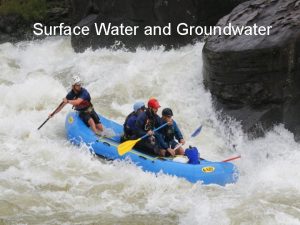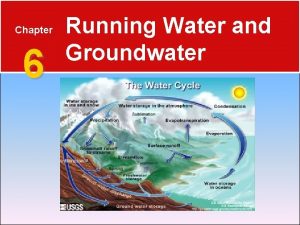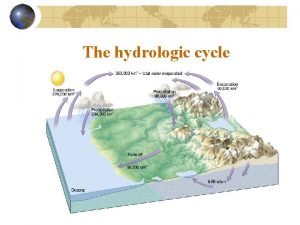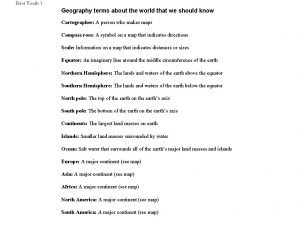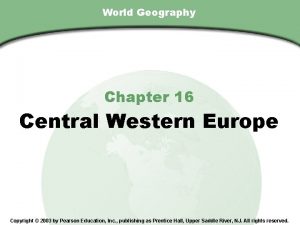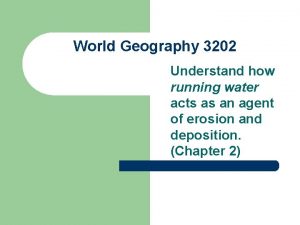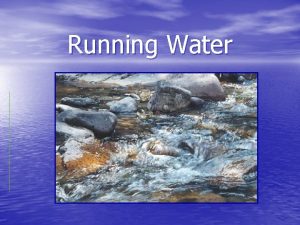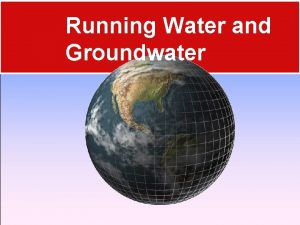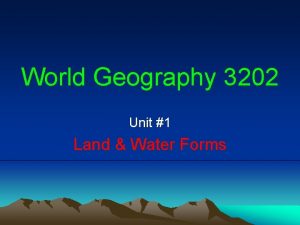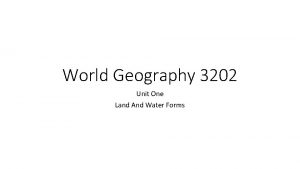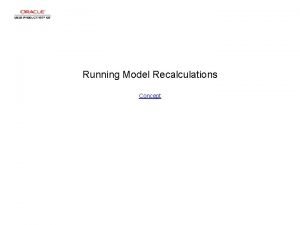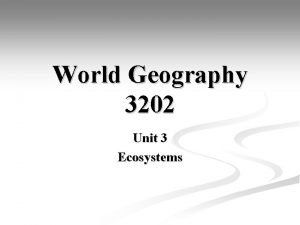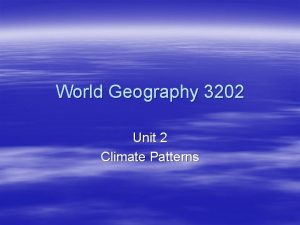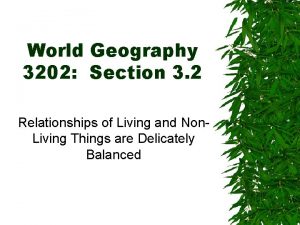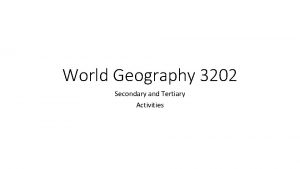World Geography 3202 Understand how running water acts

























- Slides: 25

World Geography 3202 Understand how running water acts as an agent of erosion and deposition. (Chapter 2)

1. 3. 1 Define the term drainage basin. (p. 26) l l Drainage Basin is the area of land drained by a river and its tributaries. The Amazon Basin is the planet's largest body of fresh water with 1100 tributaries 17 of which are more than 1000 miles long. Many of the tributaries begin in Colombia and Peru.

Nile River Basin l l The Nile river in Africa is the longest river in the world. The green are on the map marks the Nile River basin.

1. 3. 1/3 Describe three stages in the life cycle of a river. (P. 26) l l Rivers change over time and seem to go through three stages: 1 st Youthful rivers 2 nd Mature rivers 3 rd Old rivers

Young Rivers l l l l Usually found in highland or mountain regions Steep slope (high gradient) Small volume of water Rapid flow of water High relief on the banks Rapid erosion Narrow “V” shaped valley Water falls & rapids common

Mature Rivers l l l l Most high relief eroded Gentler slope Many well developed tributaries Broad flat river valley Well developed flood plain More lateral erosion than vertical Meandering results

Old River l l l Almost no slope Very little relief Elaborate meandering Often swampy areas around river Very muddy due to slow speed Most susceptible to flooding because of large flood plain.

Late River Maturity l l Remember the stages are not distinct. These changes occur over long periods of time.

1. 3. 2 Describe two ways in which water erosion occurs. (P. 31) l l Vertical erosion makes rivers deeper as is the case in young rivers Lateral erosion makes rivers wider leading to the meandering of mature rivers.

1. 3. 4 Define the term Delta. (P. 32) l l l Delta is a low lying area at mouth of river Deltas are formed by deposition of silt Deposition occurs because river slows as it enters ocean or lake

* 1. 3. 5 Distinguish among the terms arcuate delta, digitate delta and estuarine delta. (P. 32) l l l Arcuate Delta is named from the curved shape of a bow. Fan shaped Example Nile Delta p. 32

Digitate Delta l l Digitate Delta is adelta with long fingers of sediment reaching into the sea Example Mississippi

Estuarine Delta p. 32 l l l Estuarine Delta is formed when river runs into bay or estuary Tidal mud flats form which can be seen at low tide Sediment deposited from river outflow and from tidal inflow

Delta Similarities & Differences Similarities l l l Arcuate & digitate both flow into open ocean All three allow river water to flow out All have channels or distributaries cut into them by the river Differences l l Estuarine empties into a bay whereas other 2 empty into open water Three different shapes

Video l http: //www. youtube. com/watch? v=t. GHAO 15 h. R Os

1. 3. 3 Examine evidence to determine the life cycle stage of a river. (P. 28 questions #5 & 6) l 1. 2. 3. 4. 5. 6. Evidence to look for Slope of the river Relief of the banks Width of the valley Meandering Size of flood plain Rapids or water falls

What stage is this river in? Young l Water falls & rapids l Steep slope

What stage is this river? Early maturity l Some meandering l However still some relief l Associated with mountain

What are the Stages in a River Cycle? Youth l Rapid water movement l Rapids & water falls l High relief on banks

What kind of Delta?

What kind of Delta?

What Kind of Delta?

How are Deltas Formed l l Deltas are formed from the deposition of the sediment carried by the river as the flow leaves the mouth of the river in smaller channels called distributaries. Over long periods of time, this deposition builds the characteristic geographic pattern of a river delta.

Conditions Required to Form a Delta l l 1. The river must carry a large amount of sediments. 2. The waves or current along the coast must NOT be strong enough to remove the sediments deposited by the river, at least not faster than the river can deposit them. 3. The slope of the sea floor or lake at the river mouth must be gentle or flat. Deltas often change in size based on ocean and river currents

How Deltas are Formed l http: //www. youtube. com/watch? v=ad. Hi. Q 6 Dn 8 DI
 Once upon a time there lived a fox
Once upon a time there lived a fox Running running running
Running running running Water and water and water water
Water and water and water water To understand recursion you must understand recursion
To understand recursion you must understand recursion Running water and groundwater
Running water and groundwater Chapter 6 running water and groundwater
Chapter 6 running water and groundwater Types of running water
Types of running water 4 modifiers of human act
4 modifiers of human act Frq examples ap human geography
Frq examples ap human geography 5 themes of geography ap human geography
5 themes of geography ap human geography Ap human geography political geography test
Ap human geography political geography test World geography final jeopardy
World geography final jeopardy World history and geography final exam study guide
World history and geography final exam study guide Tertiary world geography
Tertiary world geography Arizona geographic alliance europe map
Arizona geographic alliance europe map World geography unit 9 lesson 1
World geography unit 9 lesson 1 World geography chapter 16 section 1
World geography chapter 16 section 1 Https://world-geography-games.com
Https://world-geography-games.com Latin america webquest answers
Latin america webquest answers World geography today
World geography today Highest peak in the world
Highest peak in the world 2021-2022 q1 9 week world geography cba
2021-2022 q1 9 week world geography cba Chapter 3 climates of the earth answers
Chapter 3 climates of the earth answers World geography unit 1 test
World geography unit 1 test Holt world geography today
Holt world geography today Cultural convergence definition world geography
Cultural convergence definition world geography




